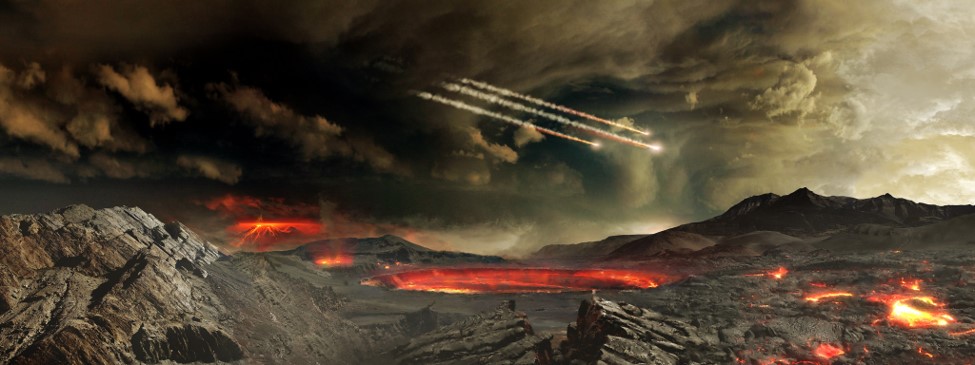
Extraterrestrial impactors of the late heavy bombardment are thought to have made Earth’s surface inhospitable to the prebiotic chemistry and biomolecules, frustrating origin-of-life scenarios. Image Credit: NASA’s Goddard Space Flight Center Conceptual Image Lab
The advent of Big Bang cosmology narrowed the history of universe to 13.8 billion years. From a naturalistic perspective, both chemical evolution and biological evolution must fit within this timeframe. (The production of extraterrestrial prebiotic and organic molecules would not be constrained to Earth’s formation 4.5 billion years ago [bya].) As plausible dates for the last universal common ancestor (LUCA) recede further and further into the past, less time is available for complex chemistry to birth first-life.
Fossil and geochemical data indicate that earliest life dates back to 3.7 bya, perhaps to 3.8+ bya.1 For example, rocks in Australia and South Africa dated at 3.3 and 3.5 bya bear the signs of fossilized prokaryotes. The carbon-12 enrichment of the samples implies past photosynthetic activity.2 Researchers do not question the early appearance of life but rather “the rapid emergence of cyanobacteria and complex photosynthetic processes.”3 pushing dates for a more chemically simplistic LUCA back even further. Chemical evolution and biological evolution therefore must vie against one another for the available cosmic time.
But as potential dates for first-life work their way further into the past, chemical evolution is pushed back into less-than-hospitable time in Earth’s history. During the late heavy bombardment (LHB), impact collisions produced a hot, molten surface that would deter the formation of a permanent land and ocean features until about 3.85 bya.4,5 A very recently published paper asserts that ancient rocks in western Greenland and Eastern Canada show signs of life from as early as 3.95 bya.6 These new dates begin to overlap with this turbulent time period when warm, little, life-friendly ponds were not likely. Appeals to the Hadean Era (prior to the LHB) appear no more accommodating and require not just one, but “multiple, independent origin-of-life scenarios.”7 Neither do hydrothermal vents scenarios provide safe haven. Scientists estimate that the entire ocean cycles through such vents every 10 million years. This destructive process once again severely limits the timeframe for origin of life (OOL) and, once again, thwarts attempts to provide a naturalistic mechanism to produce life.8
“Traditionally, origin-of-life researchers have posited that chemical evolution took place over hundreds of millions, if not billions, of years. More recent assessments allow only about ten million years for life’s origin to take place.”9 Given the available timeframe, scientists like Antonio Lazcano and Stanley Miller must simply retrofit their time estimates for the evolution of cyanobacteria to suit.10 Furthermore, all OOL scenarios require the development of delicate RNA molecules that must be soon incorporated into living systems or degrade quickly11 – an independent indicator that life must develop rapidly. Meanwhile, no viable mechanisms have been determined to potentially produce life on early Earth – slowly or rapidly.
1 Fazale Rana and Hugh Ross, Origins of Life: Biblical and Evolutionary Models Face Off (Covina, CA: Reasons to Believe, 2014), 75.
2 Ibid, 70-4.
3 Ibid, 69.
4 Ibid, 63.
5 Ibid, 88.
6 Takayuki Tashiro et al., “Early trace of life from 3.95 Ga sedimentary rocks in Labrador, Canada,” Nature 549 (2017): 516-8, http://www.nature.com/nature/journal/v549/n7673/full/nature24019.html.
7 Fazale Rana and Hugh Ross, Origins of Life: Biblical and Evolutionary Models Face Off (Covina, CA: Reasons to Believe, 2014), 91.
8 Fazale Rana, Lecture #10: “Early Earth’s Environment,” Reasons Institute “Origin of Life” online course, 2017.
9 Fazale Rana, Creating Life in the Lab (Grand Rapids: Baker, 2011), Chapter 8.*
10 Fazale Rana and Hugh Ross, Origins of Life: Biblical and Evolutionary Models Face Off (Covina, CA: Reasons to Believe, 2014), 87, 90.
11 Ibid, 90.
*Page numbers not available in Kindle version.